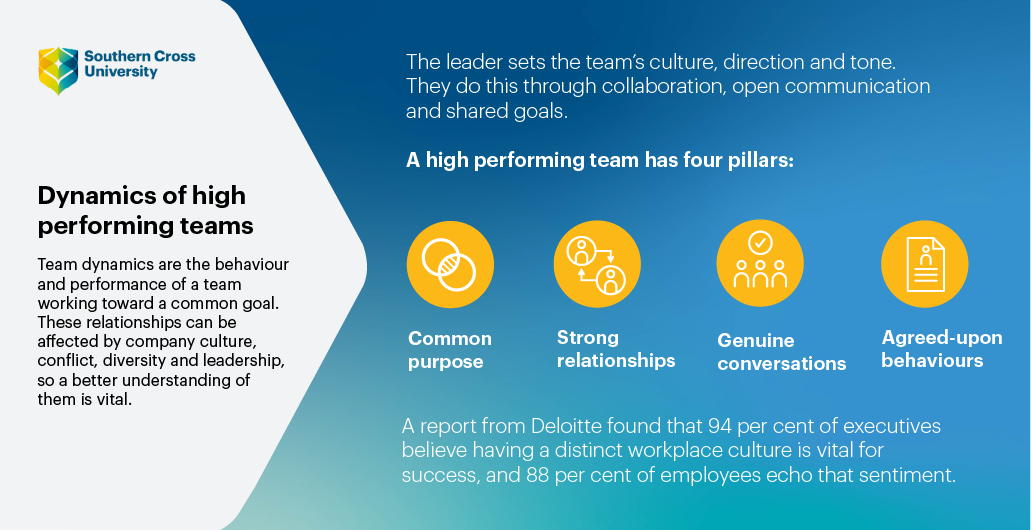The key to any successful organisation is a functional and high-performing team.
As a leader, you are responsible for building, supporting, and improving team dynamics. But what’s involved in promoting these positive team dynamics, and what can affect them?
This article explores the importance of leadership and how company culture, diversity and conflict management play a role. It also delves into why a commitment to lifelong learning and improving organisational management skills is vital for leading a powerful team.
The role of a leader in team dynamics
Team dynamics refers to the behaviour and performance of a team working towards a common goal. In a professional setting, positive team dynamics usually correlate with better performance. However, it requires a leader’s commitment to ensure success.
With an effective leader at the helm, handling and shaping team dynamics is simpler. But a leader’s duties go beyond simply managing people.
An effective leader motivates, supports and guides employees towards development and improvement. In addition, they ensure everyone in the team understands their place and purpose. So, whether they’re working on a project or the company’s everyday operations, each member needs clearly defined roles and responsibilities.
How leadership impacts team dynamics
Martine Harkin is one of the directors and facilitators at Leading Teams Australia, an organisation that helps teams and individuals to become high performing and form strong professional relationships. She believes a high-performing leader is at the core of any successful team.
“The first thing for any leader to realise is that what their people are doing is a reflection of their leadership in some way,” she says. “If they want to change the behaviour of their employees, it means changing their behaviour also. Change is possible if a leader is willing to accept some of the responsibility.”
A team leader’s role is to set the team’s direction, tone and culture. They do this by fostering an environment of open communication, collaboration and shared goals and visions. However, this can look different in every organisation, depending on the leadership style presented.
The different leadership types
Leadership affects team dynamics — for good or bad. But when considering leadership styles, is there any single one that works best for team dynamics? According to Martine, it’s not so straightforward.
“Different situations call for different leadership types,” she says. “What’s happening in front of you, who’s involved, how secure your relationship is, and how motivated they are will all impact your leadership style.”
With that in mind, these are some of the most common leadership styles used today and how they affect team dynamics.
Laissez-faire leadership
The English translation of this term is ‘let them do’, precisely what a laissez-faire leader does. These leaders hold people accountable for their work but also give them flexibility on when and how they do it. Teams working under these leaders usually feel valued, but they can also feel unclear about each person's roles and responsibilities.
Democratic leadership
This typical leadership style gives the team input, with the leader making decisions based on everyone’s opinions. Under this type of leader, everyone is made to feel that their feedback matters. However, it can slow the decision-making process or give people too much authority when they aren’t knowledgeable on a particular issue.
Strategic leadership
As well as managing a team, leaders using this style are invested in company growth and defining strategy. As a result, they can get caught up in future planning and making decisions independently, causing the team to feel neglected in the present.
Autocratic leadership
On the opposite end of democratic leadership, an autocratic leader makes all the decisions without input from the team. Although it can be beneficial in making fast decisions, the team dynamics can be impacted if individual members feel intimidated or micromanaged.
Situational leadership
A situational leader can adapt their leadership style to suit the situation, and when done correctly and by a capable manager, it’s beneficial for change and motivation. On the downside, an unskilled leader won’t be able to switch between leadership styles effectively, which can confuse the team, as they might feel uncertain about how things are handled.
Positive leadership
Recent research has identified that positive leadership behaviours (demonstrated by authentic, ethical and/or servant leaders) build employee psychological capacities that increase the capabilities and performance of employees and improve the sustainability of effective teams. Positive leaders are successful in improving team outcomes because they demonstrate emotional awareness and regulation, which facilitates effective workplace relationships, ethical behaviour and rational processing of information and decision-making.
Leading a high-performing team
Regardless of leadership style, one of the biggest goals for a successful organisation should be to have a high-performing team. But what does this look like in the workplace?
“A high-performing team usually has four pillars,” explains Martine. They have a common purpose, an agreed-upon behavioural framework, strong professional relationships, and a healthy work environment.
Of course, every workplace will be unique. Performance can be judged differently depending on the setting, industry, size of the team and the people in it. Overall, however, a high-performing team is one where all team members feel they contribute to improving performance while achieving their goals.
“It’s one of empowerment,” says Martine, “an environment that allows genuine conversation about performance that helps us get better.” Ultimately, a leader is responsible for fostering such an environment and creating a working atmosphere that allows employees to feel safe and respected.
How company culture shapes employee motivation
Company culture refers to how an organisation uses values and beliefs to guide its actions, behaviours and social patterns. It’s as influential as leadership in creating a solid team dynamic.
Just like the environment your team works in, a company’s culture can determine how team members interact with each other and their work, so it plays an important role in team dynamics.
A report from Deloitte found that 94 per cent of executives believe having a distinct workplace culture is vital to an organisation’s success. Interestingly, 88 per cent of employees do as well. As a team leader, creating, embracing and implementing this company culture begins with you.
Recent research also shows that organisations that build positive psychological capital improve team members’ hope, optimism, self-efficiency and resilience—all predictors of a high-performing and motivated team.
How companies can build a positive culture
Building a positive company culture takes consistent effort, but it’s an investment that pays off. These are some shared aspects of companies with a positive culture and how to embrace them in your team.
Human connection
A positive workplace culture supports social connections and promotes building relationships between employees. Humans have an innate need to belong and be socially accepted, so fulfilling this at work is essential. Since remote work has become the norm following the pandemic, supporting this connection has never been more critical.
Meaningful work
A positive company culture is one where employees feel connected to their work and appreciate the ‘why’ behind it. The simplest way to do this is to ensure every employee understands the purpose and importance of their role, their place in the team and the organisation’s broader vision.
Appreciation
Employee recognition is about more than offering general perks for employees, like gym memberships and financial bonuses. It should include regularly recognising and celebrating the everyday achievements of its staff.
Wellness
Health and wellness go beyond physical needs and include social and emotional wellbeing. A positive work culture emphasises employees feeling healthy and safe in these areas and implements policies to ensure it.
Systems and processes
Any good business needs systems to ensure the work is done correctly and to an agreed-upon standard. But they can also contribute to a positive culture. “Our systems and processes reward the behaviour we want to see,” says Martine. “There’s that element of challenge, that if you drift out of the expectation, someone will challenge you.”
Most important, though, is shifting our understanding of what positive means when discussing company culture.
“Positive doesn’t have to mean happy all the time,” Martine explains. “A positive company culture can come from being in a demanding, challenging environment. What comes with that is a strong professional environment and a high level of trust that creates positivity.”

What are the traits of positive company culture?
A Harvard Business Review analysis of company culture found four attributes that usually make a company successful, regardless of industry, size or vision. The analysis found a positive company culture needs to be:
- Shared. Starting from the top, employees at all levels must share and embrace a positive company culture.
- Pervasive. The culture should always be present in policies and procedures, everyday operations and how employees interact.
- Unwavering. A positive culture is solid, and there are no exceptions to the rules for certain employees or uncertainty about what they mean.
- Implicit. Healthy company culture is embedded in everything and is unspoken, with no need to discuss or display it overtly.
There are countless benefits to having a clearly defined and positive company culture. They include attracting and retaining quality staff, improving morale and performance, and better social interaction, including collaboration and teamwork. For team dynamics, these can all have a positive impact.
Team dynamics and trust
Trust is integral to a healthy working environment and positive team dynamics and needs to be prioritised when discussing company culture. However, trust should not be assumed, especially in a professional team setting.
According to Martine, trust happens by fostering an environment of clear expectations of behaviour and relationships, starting with the leadership team.
“Trust links closely to relationships,” she says. “For a leader, this means giving of self, investing time in the team, being more visible and modelling the behaviour that the team has agreed upon. All those things help build trust.”
Other strategies for building trust include open communication, creative collaboration, clear responsibilities, and regular feedback. Emphasizing diversity on the team is also vital, proving to employees that differences are accepted and not judged.
Diversity and team dynamics
A diverse workforce can support better team dynamics and performance. But what does diversity at work actually mean? Simply put, a diverse workforce comprises individuals of different ethnicities, genders, disability statuses, ages and religions.
Martine explains that diversity can also include other differences. “This can mean the diversity of thought, ways of working, personality types and learning styles.”
What are the benefits of having a diverse team?
Today’s top-performing organisations recognise the benefits of diversity in the workforce, with diversity and inclusion teams or specialists now commonplace in many companies. Consider these advantages of building and supporting diversity in organisational teams.
Better financial performance
A 2020 report from McKinsey found that diversity, equity and inclusion all contribute to better performance for an organisation. Teams with a more diverse workforce outperformed less diverse groups financially. This can be especially helpful for teams where revenue is a motivator.
More innovation
A team with unique perspectives and experience will be better equipped to meet the needs of its clients and customers. Rather than everyone sharing the same ideas, diversity means everyone coming to the table with distinctive ones. This is how diversity makes teams more innovative.
Access to talent
Organisations committed to diverse hires will have a wider talent pool from which to source staff. This gives them access to potential employees that are both proficient in their roles and good additions to the team.
Growth
Learning from others with different perspectives and backgrounds leads to individual and team growth. “Diversity can feel uncomfortable at first, but that’s a good thing,” says Martine. “If you’re not uncomfortable, you’re probably not learning much.”
How to build a diverse team
Diversity in the workplace offers many benefits, but moving from strategy to implementation requires some effort. Building a diverse team requires multiple factors, including:
- looking at diversity from all angles, including acquired and inherent diversities
- implementing policies that promote diversity, like accessibility for all staff and zero-tolerance for harassment
- adapting recruitment practices to promote diversity
- being an empathetic leader and ensuring all employees feel a sense of belonging
Of course, building a diverse team comes with its challenges. These can include overcoming bias, lack of diversity training, and implementing a diversity framework and ensuring it aligns with the company’s values and goals. However, committing to diversity with a plan and implementation strategy is a worthy investment.
Managing conflict within a team
Even with a well-assembled and diverse team, positive company culture and quality leadership, conflict still occurs in business. As such, knowing how to manage team dynamics and conflict is a skill that all leaders must possess.
There are two types of conflict that employees may experience on a team. Conflict about a specific issue, such as a difference in the time of a meeting or the details about an expected report, is easier to resolve than conflict that involves a difference in values. There are well-established processes for resolving the first type of conflict; however, the second is largely more complicated.
“The idea of conflict comes from difference,” says Martine. “Quite often, that difference is why you don’t respond to things and see the world the same way I do.”
Martine stresses that healthy conflict is critical for improvement and innovation. But to achieve it, people must feel they’re in a safe environment with positive team dynamics and mutual respect.
“Sometimes, rigorous debate can look and feel like conflict,” she says. "It’s unproductive when there’s little trust and respect in a team or a relationship.”
Conversely, conflict can be valuable in a high-performing team with healthy dynamics. “There might be raised voices, but people listen. They’re open to different views, and they feel safe enough to put their ideas on the table.”
How to resolve conflict with team members
Resolving or managing conflict allows teams to move forward and improve. Typically, the leader is responsible for taking charge. These are some common strategies a leader might use to resolve conflict in the workplace.
Set expectations
Employees must understand what constitutes acceptable behaviour, so never assume they do. With clear expectations on how people should act towards each other, conflict may be more positive.
Engage in conflict management training
All leaders and managers in an organisation need to be trained in conflict management. This ensures a consistent response to conflict you can model throughout the organisation.
Choose the proper timing
If a conflict is particularly heated, it’s best to give the involved parties time to regain composure before discussing matters further. Don’t see conflict management as something to rush through either; sometimes, it requires patience.
Open communication
Poor communication is one of the most common causes of workplace conflict. Valuing open, honest and respectful communication is vital for a well-functioning team, and it is the most effective way to resolve disputes.
Turn it into an opportunity
Conflict can be viewed as a learning opportunity for individuals and the team. Consider what lessons you can learn following the disagreement, and see what beneficial changes are possible in the future.
How can I improve my leadership skills?
Effective leadership is the foundation of a healthy team dynamic and company culture. Its core skills include conflict management and resolution, adaptability, critical thinking, and employee motivation.
Today’s leaders need to position themselves as lifelong learners to ensure they remain effective in these areas. Other benefits of ongoing education include improving agility, confidence, relevance and career progression.
Depending on your goals and requirements, there are many ways to boost your leadership skills. Postgraduate study is a popular pathway, with an MBA being viewed as the ultimate business management degree for organisational leaders.
An MBA for leaders
SCU Online’s Master of Business Administration course suits current and future leaders. In addition to topics like corporate governance and strategy, it also includes a unit on organisational behaviour and the dynamics of organisational culture.
You’ll learn about managing inter-group dynamics, human behaviour and effective communication in organisational settings. These management skills will allow you to foster a healthy team dynamic and corporate culture, leading to improved results for the rest of the organisation.
And the benefits of studying an MBA don’t stop there. They reach far beyond managing a team.
A Graduate Management Admission Council survey of corporate recruiters found that 91 per cent planned to hire MBA graduates in the next 12 months. Additionally, the demand for business managers is projected to grow by 6.1 per cent by 2026. A qualification like this can future-proof your career and equip you with the skills to manage a team effectively.
Shaping tomorrow’s teams
Behind every great team is an exceptional leader, and SCU Online can help you become one. Contact our team today on 1300 863 819 to discover the skills and opportunities that an online Master of Business Administration can give you.





